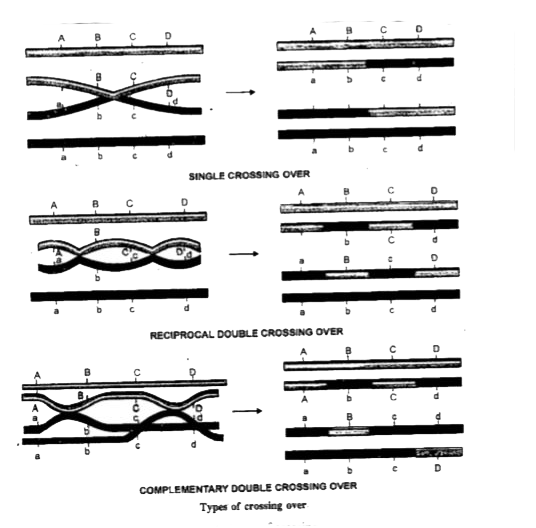Define crossing over. Explain its types. Also discuss its mechanism.

Types of crossing over. Types of Crosing Over. There are three types of crossing over-single, double and multiple. 1. Single Crossing Over. A single crossing over occurs when non-sister chromatids of a homologous pair exchange segments only at one place. It produces two recombinants and two parental types.
2. Double Crossing Over. Here exchange of segments between non-sister chromatids occurs at two places. It is of further two subtypes (a) Reciprocal Crossing Over. Crossing over occurs at two places between the same non-sister chromatids. It produces two parental types and two double cross-overs. (b) Complementary Crossing Over. In this double crossing over, three or all the four chromatids are involved hi exchange of segments. However, each crossing over occurs between non-sister chromatids. Depending upon the number of chromatids involved in double crossing over, a parental type may be absent and all the products are cross overs.or there may be one parental type, two single cross overs and one double cross over. 3. Multiple Crossing Over. Here 3, 4 or more points of exchange occur amongst the non sister chromatids of the same homologous pair of chromosomes. It is, however, less common. 4. Somatic Crossing Over. It is crossing over or exchange of chromosome segments in somatic cells. The exchange is often partial. It gives rise to unequal chromatids, e.g, Penicillium.
Crossing Over in 4 Strand Stage. In zvgotene and pachytene, the chromosomes are unsplit. It is therefore, not clear whether the bivalent formed from coming together of two homologous chromosomes has two strands or 4 strands. Single crossing over in 4 strand stage produces two parental types and two recombinants. Single crossing over in 50% of two strand bivalents will also produce the same result, i.e., two parental and two cross overs. The truth was found out in the study of crossing over in. Pink Bread Mould (Neurospora crassa). Its asci have 8 ascospores arranged in a linear.fashion. They are formed as a result of double division of meiosis followed by one mitosis. If crossing over occurs in two strand stage, the ascospores will be all recombinants and of two types arranged in 4 + 4 fashion. If crossing over occurs in 4 strand stage, there will be two parental types and two recombinant types with an arrangement of 2+2+2+2 or 2+4+2. Absence of crossing over will be indicated by arrangement of 4 + 4. A cross between normal fungus and albino fungus or an early maturing and a late maturing varieties will produce asci having an arrangement of ascospores, 4+4,2+4+2, 2+2+2+2. Clearly, crossing over occurs in the 4 strand stage.
Related Playlists
- BOOK - BETTER CHOICE PUBLICATIONCHAPTER - PRINCIPLES OF INHERITANCE AND VARIATION EXERCISE - SHORT ANSWER TYPE QUESTIONS66videos
PRINCIPLES OF INHERITANCE AND VARIATION
- BOOK - BETTER CHOICE PUBLICATIONCHAPTER - PRINCIPLES AND PROCESSES IN BIOTECHNOLOGY EXERCISE - LONG ANSWER TYPE QUESTIONS16videos
PRINCIPLES AND PROCESSES IN BIOTECHNOLOGY
- BOOK - BETTER CHOICE PUBLICATIONCHAPTER - REPRODUCTION IN ORGANISMSEXERCISE - LONG ANSWER TYPE QUESTIONS (5 MARKS)11videos
REPRODUCTION IN ORGANISMS
Similar Questions
Define buffer solution. Explain its types.
View SolutionDefine mutualism. Explain its one type.
View Solution(a)Define crossing over.
(b)Explain its mechanism with suitable diagramsView SolutionSalman exercises full control over its subordinates and takes decisions without consulting them.
Explain the leadership style. Also, discuss its major advantages and disadvantages.View SolutionDefine investment. Explain its types using suitable diagrams. .
View SolutionDefine speciation. Discuss its types.
View SolutionDefine thermal conduction. Briefly explain its molecular mechanism.
View SolutionWhat is SN2 reaction ? Discuss its mechanism.
View SolutionState and explain Newton's law of cooling. Also discuss its experimental verification.
View SolutionDefine melting point of a solid. Discuss its significance.
View Solution

